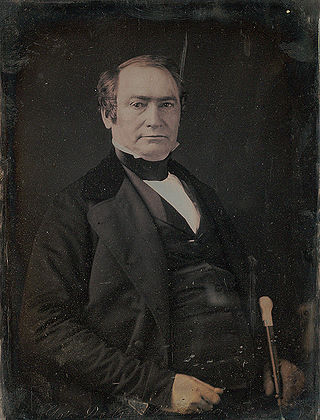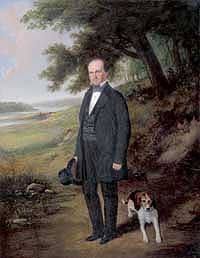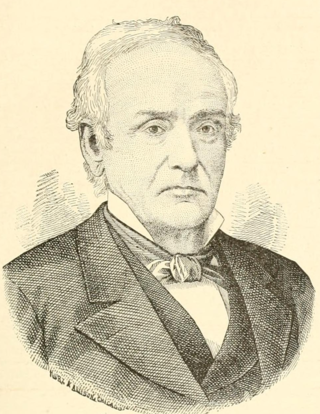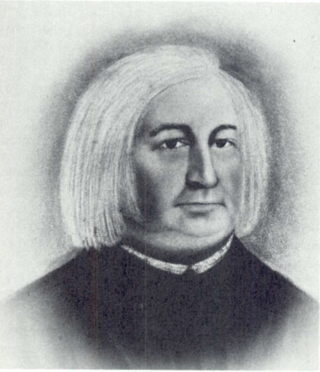Related Research Articles

The Territory of Michigan was an organized incorporated territory of the United States that existed from June 30, 1805, until January 26, 1837, when the final extent of the territory was admitted to the Union as the State of Michigan. Detroit was the territorial capital.

The Territory of Wisconsin was an organized and incorporated territory of the United States that existed from July 3, 1836, until May 29, 1848, when an eastern portion of the territory was admitted to the Union as the State of Wisconsin. Belmont was initially chosen as the capital of the territory. In 1837, the territorial legislature met in Burlington, just north of the Skunk River on the Mississippi, which became part of the Iowa Territory in 1838. In that year, 1838, the territorial capital of Wisconsin was moved to Madison.

John Scott Horner was a U.S. politician, Secretary and acting Governor of Michigan Territory, 1835–1836 and Secretary of Wisconsin Territory, 1836–1837.

James Duane Doty was a land speculator and politician in the United States who played an important role in the development of Wisconsin and Utah Territory.

George H. Walker was an American trader and politician, and was one of three key founders of the city of Milwaukee, Wisconsin. He served as the 5th and 7th Mayor of Milwaukee, and represented Milwaukee in the Wisconsin State Assembly and its predecessor body in the Wisconsin Territory.

Morgan Lewis Martin was a delegate to the United States House of Representatives from Wisconsin Territory during the 29th United States Congress (1845–1847). He also served as a member of the Wisconsin State Senate and Wisconsin State Assembly, and served as a county judge in Brown County, Wisconsin.
Thomas Pendleton Burnett was a United States politician in the Wisconsin Territory.
James Russell Vineyard was an American Democratic politician and pioneer. He served in the California State Senate and Assembly, and earlier was a member of the Wisconsin State Assembly, the legislature of the Wisconsin Territory and the 7th Michigan Territorial Council. He was infamous for shooting and killing fellow Wisconsin territorial legislator Charles C. P. Arndt on the floor of the legislature.

Albert Gallatin Ellis was one of the first American pioneers to settle in Wisconsin. He was the 2nd, 6th, 8th, and 10th Mayor of Stevens Point, Wisconsin. Before statehood, he was a member of the legislature of the Wisconsin Territory and was a publisher of the first newspaper west of Lake Michigan.
Benjamin Hyde Edgerton was an American engineer, businessman, pioneer, and politician.

The 1848 Wisconsin gubernatorial election was held on May 8, 1848. This was the election for the first Governor of Wisconsin, which became a U.S. state that year, as it was held concurrent with a public referendum to ratify the Constitution of Wisconsin.

The Sixth Michigan Territorial Council was a meeting of the legislative body governing Michigan Territory, known formally as the Legislative Council of the Territory of Michigan. The council met in Detroit in two regular sessions, one extra session, and one special session between January 7, 1834, and August 25, 1835, during the terms of George B. Porter and Stevens T. Mason as territorial governors.
The Michigan Territorial Council, known formally as the Legislative Council of the Territory of Michigan, was the legislative body of the Territory of Michigan from 1824 to 1835, when it was succeeded by the Michigan Legislature in anticipation of Michigan becoming a U.S. state. A session of the council including only members from what would become Wisconsin Territory met in 1836.
The First Legislative Assembly of the Wisconsin Territory convened from October 25, 1836, to December 9, 1836, and from November 6, 1837, to January 20, 1838, in regular session. The Assembly also convened in special session from June 11, 1838, to June 25, 1838.
Jeremiah Smith Jr. was an early settler in what is now Burlington, Iowa but was then in the Iowa District of the Michigan Territory. He worked as a merchant and land speculator, and later became a farmer and grower of fruit trees. He served as a representative for Des Moines County in the Council of the 1st Wisconsin Territorial Assembly, since at that time Iowa was part of Wisconsin Territory, from October 25, 1836, to June 25, 1838.
Joseph Bartlett Teas was an American lawyer and minister from Mt. Pleasant, Iowa. He served in the legislatures of three Territories of the United States without ever moving.

John Lawe was a pioneer fur trader, merchant, land speculator, sawmill owner and judge in Green Bay, Wisconsin Territory. He served in the brief "Rump Council" which may be regarded as the first legislature of what was to become Wisconsin.
John Parker was a local American politician in Dubuque County in the Iowa District of what was first the Michigan Territory, then the Wisconsin Territory, and eventually the Iowa Territory. He was elected to the last legislature of the old Michigan Territory to represent his district; but did not attend.
Allen Hill was an American physician from Dubuque County in the Iowa District of what was first the Michigan Territory, then the Wisconsin Territory, and eventually the Iowa Territory. He was elected to the last legislature of the old Michigan Territory to represent his district; but did not attend.
Robert C. Hoard was an American smelter, attorney and politician from Mineral Point, Wisconsin Territory who served in the legislature of the Territory and held other local offices, including that of militia captain during the Black Hawk War.
References
- Cyclopedia of Michigan: Historical and Biographical Synopsis of General History of the State, New York & Detroit: Western Publishing and Engraving, 1900, retrieved 2018-11-05
- Lorenzsonn, Axel (2010), Steam & Cinders: The Advent of Railroads in Wisconsin, Wisconsin Historical Society, retrieved 2019-01-01
- Schafer, Jack, ed. (1920), The Rump Council, The State Historical Society of Wisconsin, retrieved 2019-10-01